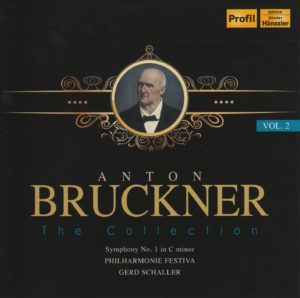 This morning’s conductor of Anton Bruckner’s Symphony No. 1 in C Minor (WAB 101) is Gerd Schaller (1965-), a German conductor highly regarded for recording Bruckner’s works, especially Bruckner’s rarer, less recorded compositions.
This morning’s conductor of Anton Bruckner’s Symphony No. 1 in C Minor (WAB 101) is Gerd Schaller (1965-), a German conductor highly regarded for recording Bruckner’s works, especially Bruckner’s rarer, less recorded compositions.
The orchestra is Philharmonie Festiva, which is also of high distinction, according to its entry on Wikipedia:
The international fame of the Philharmonie Festiva grew with its recordings of all Anton Bruckner’s symphonies, including several versions never before heard. The recordings were made in the Cistercian Abbey in Ebrach and formed part of the Bruckner cycle performed at the Ebrach Summer Music Festival.
 They had me at Cistercian Abbey.
They had me at Cistercian Abbey.
I’m a huge fan of the Cistercians, especially their abbeys. Granted, this particular one in Ebrach is a former abbey – now a youth offender’s institution – but, still. It was a Cistercian Abbey once. That counts.
First, let’s look at what’s objective:
For this recording, Schaller chose the Linz version of Symphony No. 1 (WAB 101), published in 1866. Bruckner was 41.
Schaller’s edition was recorded in 2011 at Abteikirche Ebrach (Abbey). Schaller was 46.
Bruckner wrote his symphonies in four parts. The breakdown of this one (1866 Linz version), from this particular conductor (Schaller) and this particular orchestra (Philharmonie Festiva), is as follows:
Allegro…………..14:12
Adagio……………12:52
Scherzo……………8:59
Finale……………..15:32
By way of contrast, this was the running time for Barenboim’s Symphony No. 1 (also the Linz version):
Allegro…………..13:13
Adagio……………13:45
Scherzo……………9:11
Finale……………..18:05
As you can see, the differences range from minor (Scherzo) to relatively significant (Finale).
Allegro: About a minute longer
Adagio: slightly less than a minute shorter
Scherzo: 12 seconds shorter
Finale: two and a half minutes shorter
So, if they are using the same score, the difference this time can probably be attributed to either (a) omitting parts of it, or (b) speeding up the tempo.
Okay, those are the objective stats.
Here are the subjective ones:
My Rating:
Recording quality: 5
Overall musicianship: 5
CD liner notes: 0 (there are none – boo! hiss!)
How does this make me feel: 5
This recording is superb. Not does it have tremendous energy, there’s also an indescribable magic, a charisma, to this performance. It stands out from the previous two. In a major way. (Well, to be fair, it stands out from the last one, conducted by Chailly. It’s slightly better – to my ears – than the first one, conducted by Barenboim.) The volume is sufficient. All of the instruments stand out – in their respective times in the score. (It’s not like the old joke from Deep Purple’s Made in Japan album, “Can I have everything louder than everything else.”) This is a lush, rich recording with depth and exceptional clarity.
As a reminder, here is what each term means (first two from the Wikipedia article):
Allegro = joyful; lively and fast. Moderately fast.
Adagio = ad agio, at ease. Slow, but not as slow as largo.
Scherzo = The word “scherzo,” meaning “I joke,” “I jest,” or “I play” in Italian, is a piece of music, often a movement from a larger piece such as a symphony or a sonata, often in 3/4 time. The precise definition has varied over the years, but scherzo often refers to a movement that replaces the minuet as the third movement in a four-movement work, such as a symphony, sonata, or string quartet. Scherzo also frequently refers to a fast-moving humorous composition that may or may not be part of a larger work.
Finale = the last movement of a sonata, symphony, or concerto; the ending of a piece of non-vocal classical music which has several movements; or, a prolonged final sequence at the end of an act of an opera or work of musical theatre.
 According to the book The Essence of Bruckner by Robert Simpson:
According to the book The Essence of Bruckner by Robert Simpson:
The disastrous revision of the First Symphony is a document of deep interest, if only because it reveals the disturbed condition of Bruckner’s mind at the time…If we want to know what the symphony is really like we must turn to its bold, clean Linz version, and it is unlikely that its bluntness will now strike us (as it must have done the agitated old man of the 1890s) as crudeness. Such impurities as it has are less disturbing than the anachronisms that were afterwards imposed upon it. (pages 29, 30)
Given that, why would any conductor choose to record the later Vienna version – with the sole possible reason to present it as an oddity, an aberration?
By the way, I don’t think I’ve mentioned yet that that the last minute of Adagio is sublime. I love how it gently tapers off on a high note. It’s a very beautiful, sweet piece of music.
I’m thrilled by this version of Bruckner’s Symphony No. 1. I hadn’t read much (okay, I hadn’t read anything) about Gerd Schaller when I began my research for my Bruckner project. In all of the conductor comparisons I read, I don’t recall Schaller’s name coming up at all. So, this recording comes out of nowhere – a very pleasant surprise. This is now the recording to beat.
Somebody uploaded this symphony – the Gerd Schaller version – to YouTube. You can hear Symphony No. 1 Adagio here. Pay special attention from this point to the end.
You can visit Gerd Schaller’s official web site here.
Oh, yeah. One more thing.
You may well ask, “If you’re following these conductors in alphabetical order, why did you jump from Chailly yesterday to Schaller today?”
A superb observation.
Here’s my answer: Because the conductors are also sorted by the box sets they’re in.
In this case, Schaller can be found in The Bruckner Collection. That’s “C” for Collection. Within that box set there are several (3-4 at first glance) conductors of Bruckner’s works. Rather than list all conductors separately, I chose to categorize my project by box set – 16 in all.
So, the sorting order is box set, then conductor – by alpha.
Speaking of The Bruckner Collection, for a fine-looking 20-CD box set, don’t you think a booklet of notes would have been in order? Apparently, the Profil record label didn’t think so. Not cool.
